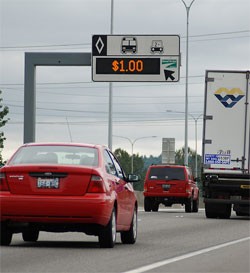Here’s an odd tidbit from a story on highway tolling in the Seattle P-I:
The [Washington] Highway 167 HOT lanes cost about $90,600 per month to operate, on average, and take in about $52,600 in tolls per month. [Emphasis added.]
 For those who aren’t hip to the lingo, HOT stands for “high occupancy/toll“—basically, HOV lanes that solo drivers can use for a fee. Ideally, HOT lane tolls are tuned to keep traffic flowing: high enough to keep HOV lanes from bogging down, but low enough to encourage some drivers to skip out of the toll-free lanes when they start to get crowded. And HOT lane tolls can be collected electronically, so there are no tollbooths to slow down traffic.
For those who aren’t hip to the lingo, HOT stands for “high occupancy/toll“—basically, HOV lanes that solo drivers can use for a fee. Ideally, HOT lane tolls are tuned to keep traffic flowing: high enough to keep HOV lanes from bogging down, but low enough to encourage some drivers to skip out of the toll-free lanes when they start to get crowded. And HOT lane tolls can be collected electronically, so there are no tollbooths to slow down traffic.
As far as I know, Washington’s Highway 167, south and a bit east of of Seattle, has the only HOT lanes in the Northwest; but there are similar projects in California, Colorado, Minnesota, Florida, Utah, and Texas, as well as HOT lane plans elsewhere in the country.
But what caught my attention in the quote above was the costs: the 167 HOT lanes don’t even take in enough revenue to cover the costs of collecting the tolls, let alone the cost of installing the tolling equipment. And there’s certainly not enough money in the Highway 167 tolls to pay for new roads or improved transit service.
So what does this mean for the future of road tolling in the Northwest?
Just to be clear, you probably can’t read too much into what’s happening on Highway 167. It’s a small pilot project, so the costs are bound to be much higher than they’d be if the technology were scaled up.
Still, the financial results have be at least a little bit troubling for those who are hoping to use tolls to help finance highway expansions: if tolling can’t even pay for itself, it certainly can’t pay for other transportation projects. Seattle’s Alaskan Way tunnel project is facing similar issues: traffic studies suggest that if tolls are set too low, there won’t be enough money to pay for the construction costs (not that tolls will pay for more than a fraction of those costs anyway); but if they’re too high, lots of drivers will choose I-5 or city streets over the tunnel—exacerbating the very rush hour congestion problems that the tunnel is supposed to solve. And if the experience with Highway 167 is any guide, it’s easy to believe that drivers will forego a tolled lane if there’s a free alternative.
But I think it’s a mistake to see the Highway 167 HOT lane results as repudiating the idea of road tolling in general. The thing is that everyone driving on Highway 167benefits from the existence of the tolled lane: the people who choose to pay the toll are doing so willingly, because they feel that their time is worth at least as much as what they’re paying; but the people who stay in the free lanes also see a benefit, since every solo driver who switches to the HOT means one less car clogging the free lanes.
In fact, when you sum up the total benefit to road users created by HOT lanes, it’s likely to be a lot higher than the toll revenue alone: the time savings from congestion relief outweigh the costs to drivers. That’s exactly this comprehensive study of road tolling in the Puget Sound found—the estimated net public benefit from tolling vastly exceeded the projections for toll revenue.
Which suggests to me that tolling can be worthwhile public policy with significant benefits for drivers—even if the early financial results aren’t what the road-building lobby might have hoped for.
[HOT lane photo courtesy of WSDOT, released under a Creative Commons license. Hat tip to Joe Cortright.]

Comments are closed.